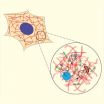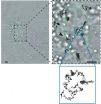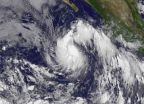(Press-News.org) Cambridge, Mass. – August 14, 2014 – Conventional wisdom holds that the cytoplasm of mammalian cells is a viscous fluid, with organelles and proteins suspended within it, jiggling against one another and drifting at random. However, a new biophysical study led by researchers at Harvard University challenges this model and reveals that those drifting objects are subject to a very different type of environment.
The cytoplasm is actually an elastic gel, it turns out, so it puts up some resistance to simple diffusion. But energetic processes elsewhere in the cell—in the cytoskeleton, especially—create random but powerful waves in the cytoplasm, pushing on proteins and organelles alike. Like flotsam and jetsam buffeted by the wakes of passing ships, suspended particles scatter much more quickly and widely than they would in a calm sea.
Because transport within the cytoplasm therefore depends mainly on separate processes that consume energy, a measurement of the spectrum of forces exerted on the cytoplasm at any given time can provide a snapshot of the metabolic state of the cell.
Led by David A. Weitz, Mallinckrodt Professor of Physics and Applied Physics at the Harvard School of Engineering and Applied Sciences (SEAS), a team of applied physicists and cell biologists have put forth this new model of the cytoplasm and demonstrated a way to quantify the aggregate forces felt by particles and organelles in the cell. Their findings, published online August 14 in the journal Cell, raise a host of new questions about cellular dynamics. They also provide a robust new tool for future investigations.
"Our research provides the first real physical understanding of the cytoplasm in mammalian cells," says lead author Ming Guo, Ph.D. '14, a former graduate student in applied physics at Harvard SEAS who is now continuing as a postdoctoral fellow to further explore the fundamental biophysics of cells. "This work is going to be critical for future research on development, cancer biology, and metabolism."
Until now, cell biologists have assumed that particles and other objects passively diffuse through the cytoplasm because they collide randomly with neighboring molecules—a process called thermal diffusion or Brownian motion. After all, under a microscope, the jerky movements of such particles do resemble thermal diffusion. Relying on this assumption, and lacking the tools to test it, Guo says, researchers in the field have underestimated the importance of the cytoplasm as a participant in more complex cell dynamics.
"I talked to many people at different universities, and it seems a lot of them think, 'Oh, this is very straightforward—this should just be thermal diffusion,'" he explains. "It's such a beautiful idea. It's very simple. It makes perfect sense. But it's just not the case."
Just as a spoon can stir up sugar in a coffee cup, helping it to dissolve, the operations of cellular machinery prevent suspended particles from settling into equilibrium. Molecular motors that repeatedly tug on strings of actomyosin, the building blocks of muscle fibers, are the main culprit, but other enzymatic activities can also create these waves.
Guo, Weitz, and their collaborators tested this theory through a series of "knockout" experiments in which they removed the cells' fuel source, adenosine triphosphate (ATP). In the starved cells, suspended particles and endogenous organelles traveled far more slowly.
They also developed a new procedure for measuring the overall magnitude of the fluctuating forces within the cytoplasm of live cells, as well as the dependence of these forces on frequency. They call it force spectrum microscopy (FSM), because it uses a combination of microscopy, microrheology, and optical tweezers to measure the stiffness of the cytoplasm and the movement of an injected, inert particle. The difference between the observed movement and the expected thermal movement from the measured cytoplasmic mechanics provides enough information for them to calculate the other forces within the cell.
"This is the first time it has been possible to measure the aggregate forces in a cell, which now will allow us to distinguish the state of its motor or enzymatic activity under different conditions or subjected to different stimuli," says Weitz. "That information should provide a completely new perspective on cell behavior."
In addition to his role at Harvard SEAS, Weitz is the director of Harvard's Materials Research Science and Engineering Center, co-director of the BASF Advanced Research Initiative, a member of the Kavli Institute for Bionano Science & Technology, and an associate of the Wyss Institute for Biologically Inspired Engineering.
"Our results imply that factors affecting the activities of molecular motors indirectly orchestrate the overall rheology of the cytoplasm," says coauthor Jennifer Lippincott-Schwartz, Distinguished NIH Investigator and Chief of the Section on Organelle Biology at the Eunice Kennedy Shriver National Institute of Child Health and Human Development (NICHD).
"The conclusion that the cytoplasm is best modeled as an elastic gel, out of equilibrium, rather than as a Brownian-based fluid has important implications," she says. "It means that factors modulating the stiffness and motion of the cytoplasm derive from the cell's underlying energetic state."
The research team observed this in practice when they measured and compared the cytoplasmic forces within benign and malignant breast cells. The hyperactive malignant cells exhibited much stronger aggregate forces.
In short, changes in the activities of molecular motors and other enzymatic activity can affect cellular properties like the stiffness of the cytoplasm and how easily objects can move within it. Cytoplasmic changes might then affect other cellular activities, further downstream. Future studies using force spectrum microscopy may shed new light on the elastic properties of both the cytoplasm and the nucleoplasm, and how these properties affect gene expression, metabolic signaling, cell growth, and motility.
INFORMATION:
In addition to Guo, Weitz, and Lippincott-Schwartz, coauthors included Allen J. Ehrlicher, formerly a postdoctoral fellow at Harvard SEAS and Beth Israel Deaconess Medical Center, now an assistant professor at McGill University; Mikkel H. Jensen, formerly of Boston University and now a postdoctoral fellow at Harvard SEAS; Malte Renz, a former postdoc at NICHD, now a resident physician at Albert Einstein College of Medicine; Jeffrey R. Moore, a biophysicist at Boston University; Robert D. Goldman, a cell biologist at Northwestern University's Feinberg School of Medicine; and Frederick C. Mackintosh, a physicist at VU University in the Netherlands.
This research was supported in part by the National Institutes of Health (PO1GM096971, DK083592, HL86655), the National Science Foundation (NSF) (DMR-1310266) and the NSF-funded Harvard Materials Research Science and Engineering Center (DMR-0820484), the Netherlands Organization for Scientific Research (NWO) Foundation for Fundamental Research on Matter (FOM), and Hannah's Hope Fund.
Inside the cell, an ocean of buffeting waves
New understanding of the cytoplasm suggests active processes generate crucial forces
2014-08-14
ELSE PRESS RELEASES FROM THIS DATE:
Forcing chromosomes into loops may switch off sickle cell disease
2014-08-14
Scientists have altered key biological events in red blood cells, causing the cells to produce a form of hemoglobin normally absent after the newborn period. Because this hemoglobin is not affected by the inherited gene mutation that causes sickle cell disease, the cell culture findings may give rise to a new therapy for the debilitating blood disorder.
The novel approach uses protein-engineering techniques to force chromatin fiber, the substance of chromosomes, into looped structures that contact DNA at specific sites to preferentially activate genes that regulate hemoglobin. ...
NASA sees Tropical Storm Julio now far from Hawaii
2014-08-14
Hurricane Julio moved past the Hawaiian Islands like a car on a highway in the distance, and NASA's Terra satellite captured an image of the storm, now downgraded to a tropical storm located more than 700 miles away. Julio is far enough away from Hawaii so that there are no coastal watches or warnings in effect.
On August 13 at 21:10 UTC (5:10 p.m. EDT), the Moderate Resolution Imaging Spectroradiometer of MODIS instrument aboard NASA's Terra satellite captured a visible image of Hurricane Julio moving through the Central Pacific Ocean. The visible image shows that powerful ...
EARTH Magazine: Are slow-slip earthquakes under Tokyo stressing faults?
2014-08-14
Alexandria, Va. — Tokyo, a city of more than 13 million people, has been devastated by earthquakes in the past and likely will be again. But when? And what role do ongoing slow-slip earthquakes — the kind that generally can't be felt at the surface — play in relieving or building up stress?
New research examining plate movements under Tokyo has found that since the massive magnitude-9 Tohoku earthquake and tsunami in March 2011, recurrence intervals for nondamaging slow-slip quakes beneath Japan's capital have shortened. That has left seismologists wondering if this aseismic ...
A husband's declining health could put Taiwanese women at risk for health issues
2014-08-14
PRINCETON, N.J.—The death of a spouse undoubtedly brings with it stress, anxiety and uncertainty. Now, a report by Princeton University's Woodrow Wilson School of Public and International Affairs quantifies this stress, showing how a husband's declining health could put Taiwanese women at risk for health issues.
Using data from a longitudinal sample of Taiwanese older adults, the researchers found that the more a husband suffered, the more his wife's glucose levels increased. Yet, when a wife's health was declining, her husband's levels remained the same. Being widowed, ...
High prevalence of opioid use by Social Security disability recipients, reports Medical Care
2014-08-14
August 14, 2014 – More than 40 percent of Social Security Disability Insurance (SSDI) recipients take opioid pain relievers, while the prevalence of chronic opioid use is over 20 percent and rising, reports a study in the September issue of Medical Care. The journal is published by Lippincott Williams & Wilkins, a part of Wolters Kluwer Health.
The high proportion of SSDI recipients who are chronic opioid users—in many, at high and very high daily doses—"is worrisome in light of established and growing evidence that intense opioid use to treat non-malignant [non-cancer] ...
Tropical Storm Karina forms in Eastern Pacific near Socorro Island
2014-08-14
Socorro Island in the Eastern Pacific received an unwelcome tropical visitor on the morning of August 13 when satellite data confirmed the formation of Tropical Storm Karina.
Karina strengthened from the eleventh tropical depression in the Eastern Pacific. Tropical Depression 11-E formed at 11 p.m. EDT on August 12. Just twelve hours later at 11 a.m. EDT, the depression had become better organized and winds increased to tropical storm strength.
NOAA's GOES-West satellite captured an infrared image of newborn Tropical Storm Karina approaching Socorro Island in the Eastern ...
NASA sees fragmented thunderstorm bands wrapped around Tropical Storm Karina
2014-08-14
Although Tropical Storm Karina is still strengthening in the Eastern Pacific Ocean NASA's Aqua satellite revealed a large band of fragmented thunderstorms wrapping into its center from the north.
On August 13 at 21:00 UTC (5 p.m. EDT), the MODIS or Moderate Resolution Imaging Spectroradiometer instrument aboard NASA's Aqua satellite captured a visible image of Tropical Storm Karina off the west coast of Mexico. The image showed a concentration of strong thunderstorms around the center of circulation while the band of thunderstorms to the north appeared broken. The strongest ...
Novel treatment strengthens bones in genetic disease neurofibromatosis type-1
2014-08-14
An enzyme therapy may prevent skeletal abnormalities associated with the genetic disorder neurofibromatosis type-1, Vanderbilt investigators have discovered.
The researchers demonstrated in a mouse model of the disorder that the enzyme asfotase-alpha improves bone growth, mineralization and strength. The findings, reported in the August issue of Nature Medicine, "suggest that we can make bone stronger and better by injecting this drug, and possibly prevent fractures in patients with neurofibromatosis," said Florent Elefteriou, Ph.D., director of the Vanderbilt Center for ...
NTU gene research promises better treatment procedures for children with leukemia
2014-08-14
A research team led by Nanyang Technological University (NTU) scientists have made a key finding which is expected to open up improved treatment possibilities for children suffering from leukaemia.
They found that two in three cases of acute lymphoblastic leukaemia, a type of cancer of the white blood cells, may be caused by mutations in one of the two key genes found in children. These genes are however more prevalent in those with Down syndrome.
This means that scientists can design better tailored treatment protocols, depending on which mutating gene is carried ...
New technology offers insight into cholesterol
2014-08-14
Researchers from the Copenhagen Center for Glycomics at the University of Copenhagen have studied an important receptor protein called LDLR using new, groundbreaking techniques. The protein plays an important role in the absorption of the bad cholesterol, LDL.
The findings have just been published in the Journal of Biological Chemistry.
The key to major discoveries within the fields of health and diseases is not just hidden in the human DNA code. The proteins encoded by the genes also play an important role, not least the attached sugar chains which give the proteins ...
LAST 30 PRESS RELEASES:
Diversifying US Midwest farming for stability and resilience
Emphasizing immigrants’ deservingness shifts attitudes
Japanese eels, climate change, and river temperature
Pusan National University researchers discover faster, smarter heat treatment for lightweight magnesium metals
China’s 2024 Gastroenterology Report: marked progress in endoscopy quality and disease management
Pusan National University researchers uncover scalable method for ultrahigh-resolution quantum dot displays
Researchers use robotics to find potential new antibiotic among hundreds of metal complexes
Gut bacteria changes at the earliest stages of inflammatory bowel disease
Scientists develop new way to “listen in” on the brain’s hidden language
Brain research: “Pulse generators” grow and shrink as memories are formed
For teens, any cannabis use may have impact on emotional health, academic performance
School meals could unlock major gains for human and planetary health
Menopause hormone therapy does not appear to impact dementia risk
Signature patterns of brain activity may help predict recovery from traumatic brain injury
Dresden study uncovers new key mechanism in cancer cells
New species are now being discovered faster than ever before, study suggests
Cannabis-based products show limited short-term benefit for chronic pain, with increased risk of adverse effects
Cannabis products with more THC slightly reduce pain but cause more side effects
Clearing the brain of aging cells could aid epilepsy and reduce seizures
Brain injuries linked with potential risk of suicide, new study finds
New technique lights up where drugs go in the body, cell by cell
New study finds movement of fishing fleets can reveal shifts in marine ecosystems
Embargoed: New evidence points to potential treatment for vascular dementia
Study uncovers disrupted brain balance in alcohol dependence
Working in groups can help Republicans and Democrats agree on controversial content moderation online
Structural findings reveal how distinct GPCR ligands create different levels of activation
Anything-goes “anyons” may be at the root of surprising quantum experiments
UC review: Maximizing workplace opportunity for veterans
From generation to complex control: Metasurfaces make perfect vortex beams "within reach"
Thin-film lithium niobate-based detector: recent advances and perspectives
[Press-News.org] Inside the cell, an ocean of buffeting wavesNew understanding of the cytoplasm suggests active processes generate crucial forces






